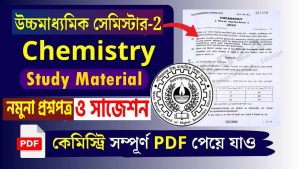2024 Latest WBJEE Syllabus and Notes PDF Download can be easily accessed on the official website. We have mentioned the subject-wise important topics from WBJEE Syllabus for Physics, Chemistry and Mathematics in the section below.
WBJEE Syllabus 2025 – Check Physics, Chemistry, Mathematics
WBJEE 2025 syllabus will consist of topics from Physics, Chemistry and Mathematics. Along with the syllabus, the candidates are also advised to check the WBJEE 2025 exam pattern. Read the full article to know more about WBJEE Syllabus 2025.

WBJEE Mathematics Syllabus 2022
Algebra A.P., G.P., H.P.: Definitions of A. P. and G.P.; General term Arithmetic/Geometric series, A.M., G.M. and their relation; ; Summation of first n-terms of series ∑n, ∑n²,∑n3 ;Infinite G.P. series and its sum.
Permutation and combination: Permutation of n different things taken r at a time (r ≤ n), Permutation with repetitions (circular permutation excluded), Permutation of n things not all different, Combinations of n different things taken r at a time (r ≤ n), Basic properties, Combination of n things not all different, Problems involving both permutations and combinations.
Complex Numbers: Definition in terms of ordered pair of real numbers and properties of complex numbers, Triangle inequality; amplitude of complex numbers and its properties; Complex conjugate; Square root of complex numbers; De Moiré’s theorem (statement only) and its elementary applications, Cube roots of unity, Solution of quadratic equation in complex number system.
Binomial theorem (positive integral index): Statement of the theorem, middle term, equidistant terms, general term, properties of binomial coefficients.
Trigonometry: Trigonometric functions, formulae involving multiple and submultiple angles, addition and subtraction formulae, general solution of trigonometric equations, inverse trigonometric functions and their properties, Properties of triangles.
Co-ordinate geometry of three dimensions: Direction cosines and direction ratios, equation of a straight line, equation of a plane, distance between two points and section formula, distance of a point from a plane.
Sets, Relations and Mappings: Idea of sets, subsets, power set, complement, union, intersection and difference of sets, De Morgan’s Laws, Venn diagram, Inclusion/ Exclusion formula for two or three finite sets, Relation and its properties, Cartesian product of sets, Equivalence relation — definition and elementary examples, injective, subjective and bijective mappings, mappings, range and domain, composition of mappings, inverse of a mapping.
Integral calculus: Integration as a reverse process of differentiation, Integration by parts, indefinite integral of standard functions, Integration by substitution and partial fraction, Fundamental theorem of integral calculus and its applications, Definite integral as a limit of a sum with equal subdivisions, Properties of definite integrals.
Logarithms: Definition; General properties, Change of base.
Polynomial equation: nth degree equation has exactly n roots (statement only), Relations between roots and coefficients; Nature of roots; Formation of a quadratic equation, Quadratic Equations: Quadratic equations with real coefficients, sign and magnitude of the quadratic expression ax2 +bx+c (where a, b, c are rational numbers and a ≠ 0).
Application of Calculus: Tangents and normal, Determination of monotonicity, maxima and minima, conditions of tangency, Differential coefficient as a measure of rate, Geometric interpretation of definite integral as area, Motion in a straight line with constant acceleration, calculation of area bounded by elementary curves and Straight lines, Area of the region included between two elementary curves.
Principle of mathematical induction: Statement of the principle, sum of cubes of first n natural numbers, proof by induction for the sum of squares, divisibility properties like 22n — 1 is divisible by 3 (n ≥ 1), 7divides 3 2n+1+2n+2 (n ≥ 1).
Matrices: Concepts of m x n (m ≤ 3, n ≤ 3) real matrices, scalar multiplication and multiplication of matrices, operations of addition, Determinant of a square matrix, Transpose of a matrix, Properties of determinants (statement only), Nonsingular matrix, Inverse of a matrix, Minor, cofactor and adjoin of a matrix, Finding area of a triangle, Solutions of system of linear equations.
WBJEE Physics Syllabus 2022
Physical World, Measurements, Units & dimensions: Physical World, Measurements, Units & dimensions Units & Dimensions of physical quantities, dimensional analysis & its applications, error in measurements, significant figures.
Kinematics: Scalars & vectors, representation of vectors in 3D, dot & cross product & their applications, elementary differential & integral calculus, time-velocity & relevant graphs, equations of motion with uniform acceleration.
Laws of motion: Newton’s laws of motion, using algebra & calculus, inertial & non inertial frames, conservation of linear momentum with applications, elastic & inelastic collisions, impulse centripetal force, banking of roads, relative velocity, projectile motion & uniform circular motion Work, power, energy: Work, power, energy Work, work-energy theorem, power, energy, work done by constant & variable forces, PE & KE, conservation of mechanical energy, conservative and nonconservative forces, PE of a spring,
Motion of centre of mass, connected systems, Friction: Centre of mass of two-particle system, motion of connected system, torque, equilibrium of rigid bodies, moments of inertia of simple geometric bodies (2D) [without derivation] conservation of angular momentum, friction and laws of friction.
Gravitation: Kepler’s laws, (only statement) universal law of gravitation, acceleration due to gravity (g), variation of g, gravitational potential & PE, escape velocity, orbital velocity of satellites, geostationary orbits.
Bulk properties of matter: Elasticity, Hooke’s law, Young’s modulus, bulk modulus, shear, rigidity modulus, Poisson’s ratio elastic potential energy. Fluid pressure: Pressure due to a fluid column, buoyancy, Pascal’s law, effect of gravity on fluid pressure. Surface tension: Surface energy, phenomena involving surface tension, angle of contact, capillary rise,
Viscosity: Coefficient of viscosity, streamline & turbulent motion, Reynold’s number, Stoke’s law, terminal velocity, Bernoulli’s theorem. Heat & Thermal Physics: Heat & temperature, thermal expansion of solids. liquids & gases, ideal gas laws, isothermal & adiabatic processes; anomalous expansion of water & its effects, sp. heat capacity, Cp, Cv, calorimetry; change of state, specific latent heat capacity. Heat transfer; conduction, thermal and thermometric conductivity, convection & radiation, Newton’s law of cooling, Stefan’s law.
Thermodynamics: Thermal equilibrium (Zeroth law of thermodynamics), heat, work & internal energy. 1st law of thermodynamics, isothermal & adiabatic processes, 2nd law of thermodynamics, reversible & irreversible processes.
Kinetic theory of gases: Equation of state of a perfect gas, kinetic theory of gases, assumptions in Kinetic theory of gases, concept of pressure. & temperature; rms speed of gas molecules; degrees of freedom, law of equipartition of energy (introductory ideas) & application to specific heats of gases; mean free path, Avogadro number.
Oscillations & Waves: Periodic motion – time period, frequency, time-displacement eqation, Simple harmonic motion (S.H.M) & its equation; phase; SHM in different sytems, restoring force & force const, energy in S.H.M.- KE & PE, free, forced & damped oscillations (introductory ideas), resonance wave motion, equation for progressive wave, longitudinal & transverse waves, sound waves, Newton’s formula & Laplace’s correction, factors affecting the velocity of sound in air, principles of superposition of waves, reflection of waves, standing waves in strings & organ pipes, fundamental mode, harmonics &overtones, beats, Doppler effect.
Electrostatics: Conservation of electric charges, Coulomb’s law-force between two-point charges, forces between multiple charges; superposition principle & continuous charge distribution. Electric field, & potential due to a point charge & distribution of charges, electric field lines electric field due to a dipole; torque on a dipole in uniform electric field; electric flux, Gauss’ theorem & its simple applications, conductors & insulators, free charges & bound charges inside a conductor; dielectrics & electric polarisation, capacitors & capacitance, combination of capacitors in series & in parallel, capacitance of a parallel plate capacitor with & without dielectric medium between the plates, energy stored in a capacitor.
Current Electricity:
Electric current, & conductor, drift velocity’ mobility & their relation with electric current; Ohm’s law, electrical resistance, Ohmic and non-Ohmic conductors, electrical energy & power, carbon resistors, colour codes, combination of resistances, temperature dependence of resistances, electric cell, emf and internal resistance of an electric cell, pd, combination of cells, secondary cells, (introductory) Kirchoff’s laws of electrical network, simple applications, principle of Wheatstone bridge, metre bridge and potentiometer and their uses, thermoelectricity; Seebeck effect; Peltier effect, thermo emf.
Magnetic effect of current: Concept of magnetic field, Oersted’s experiment, Biot – Savart law & its application to current carrying circular loop; Ampere’s law & its applications to infinitely long straight wire, straight and toroidal solenoids; force on a moving charge in uniform magnetic & electric fields, cyclotron frequency; force on a current-carrying conductor in a uniform magnetic field, force between two parallel current-carrying conductors– definition of ampere. Torque experienced by a current loop in a uniform magnetic field; moving coil galvanometer-its current sensitivity & conversion to ammeter & voltmeter, Inter-conversion of voltmeter & ammeter & change of their ranges.
Magnetics: Current loop as a magnetic dipole & its magnetic dipole moment, magnetic dipole moment of a revolving electron, magnetic field intensity due to a magnetic dipole bar magnet along its axis & perpendicular to its axis, torque on a magnetic dipole (bar magnet) in a uniform magnetic field; magnet as an equivalent solenoid, magnetic field lines; Earth’s magnetic field & its magnetic elements. para-, dia- & ferro- magnetic substances, with examples. Electromagnets & the factors affecting their strengths, permanent magnets.
Electromagnetic induction & alternating current: Electromagnetic induction; Faraday’s laws, induced emf & current; Lenz’s Law, eddy currents, self & mutual induction, alternating currents, peak and rms value of alternating current and voltage; reactance and impedance; LR & CR circuits, phase lag & lead, LCR series circuit, resonance; power in AC circuits, wattless current.
Electromagnetic waves: Electromagnetic waves and their characteristics (qualitative ideas only), transverse nature of electromagnetic waves, electromagnetic spectrum, applications of the waves from the different parts of the spectrum
Optics I (Ray optics): Reflection of light, spherical mirrors, mirror formula. Refraction of light, total internal reflection & its applications, optical fibres, refraction at spherical surfaces, lenses, thin lens formula, lensmaker’s formula. Newton’s relation: Displacement method to find position of images (conjugate points) Magnification, power of a lens, combination of thin lenses in contact, combination of a lens & a mirror refraction and dispersion of light through a prism; optical instruments, human eye, image formation & accommodation, correction of eye defects (myopia, hypermetropia) using lenses, microscopes & astronomical telescopes (reflecting & refracting) & their magnifying powers.
Optics II (Wave Optics): Scattering of light – blue colour of the sky, elementary idea of Raman effect; wave optics: wave front & Huygens’ principle, reflection & refraction of plane wave at a plane surface using wave fronts. Proof of laws of reflection & refraction using Huygens’ principle Interference, Young’s double slit experiment & expression for fringe width, coherent sources, Fraunhoffer diffraction due to a single slit,
Particle nature of light & wave particle dualism: Photoelectric effect, Hertz and Lenard’s observations; Einstein’s photoelectric equation – particle nature of light, matter waves; wave nature of particles, de Broglie relation.
Atomic Physics: Alpha-particle scattering expt Rutherford’s nuclear atom model of atom; Bohr model of hydrogen atom, energy levels in a hydrogen atom, hydrogen spectrum, continuous & characteristic xrays.
Nuclear Physics: Composition & size of nucleus, atomic masses, isotopes, isobars; isotones, radioactivity – alpha, beta & gamma particles/ rays & their properties; radioactive decay law; massenergy relation, mass defect; binding energy per nucleon & its variation with mass number; nuclear fission & fusion.
Solid state Electronics: Energy bands in solids (qualitative ideas only), conductors, insulators & semiconductors; semiconductor diode – I-V characteristics in forward & reverse bias, diode as a rectifier;
- characteristics of LED, photodiode, solar cell & Zener diode; Zener diode as a voltage regulator, junction transistor (BJT), transistor action, characteristics of a BJT, BJT as an amplifier (CE configuration) & oscillator; logic gates (OR, AND, NOT, NAND & NOR).
WBJEE Chemistry Syllabus 2022
Atomic Structure: Concept of Nuclear Atom – electron, proton and neutron (charge and mass), Rutherford’s model and its limitations, atomic number, Extra nuclear structure; Line spectra of hydrogen atom, Bohr’s model of hydrogen atom and its limitations, Quantization of energy (Planck’s equation E = hν), Somerfield’s modifications (elementary idea), The four quantum numbers, The Aufbau Principle; Pauli’s Exclusion Principle and Hund’s Rule, ground state electronic configurations of many electron atoms and mono – atomic ions.
Coordination Compounds: Introduction, coordination compounds (examples only), Werner’s theory, coordination number (examples of coordination number 4 and 6 only), Double salts and complex salts, colour, magnetic properties and shapes, IUPAC nomenclature of mononuclear coordination compounds.
The Periodic Table and Chemical Families: Modern periodic law (based on atomic number), Modern periodic table based on electronic configurations, Types of elements – representative (s-block and p- block), transition (d-block) elements and inner transition (f-block/lanthanides and actinides) and their general characteristics, groups (Gr. 1-18) and periods.
Gaseous State: Measurable properties of gases, absolute scale of temperature, Boyle’s Law and Charles Law, kinetic theory of gases, root mean square and most probable velocities and their relationship with temperature, ideal gas equation – average, Daltons Law of partial pressure, Deviations from ideal behavior, Grahams Law of gaseous diffusion, Liquefaction of gases, real gases, van der Waals equation, Numerical problems.
Hydrogen: Occurrence, isotopes, preparation, properties and uses of hydrogen, Position of hydrogen in periodic table, hydrides-ionic covalent and interstitial, heavy water, hydrogen peroxide – preparation, reactions and structure and use, physical and chemical properties of water, hydrogen as a fuel.
Chemical Dynamics: Factors affecting the rate of chemical reactions (concentration, pressure, temperature, catalyst), Arrhenius equation and concept of activation energy, Concept of collision theory, Order and molecularity (determination excluded), First order reactions, half – life (numerical problems), examples of first order and second order reactions, rate constant.
General principles of metallurgy: Occurrence, concentration of ores, mineral wealth of India, production and purification of metals, Typical metals (Na, Ca, Al, Fe, Cu and Zn) – occurrence, extraction, purification (where applicable), properties and reactions with air, water, acids and non-metals. Manufacture of steels and alloy steel (Bessemer, Open-Hearth and L.D. process).
Chemistry in Industry: Large scale production (including physicochemical principles where applicable, omitting technical details) and Ammonia (Haber’s process), uses of Sulphuric acid (contact process), Nitric acid (Ostwald’s process), sodium carbonate (Solvey process).
Environmental Chemistry: Common modes of pollution of air, water and soil, important chemical reactions in the atmosphere, Ozone layer, ozone hole, Smog; major atmospheric pollutants, Global warming pollution due to industrial wastes, Green House effect, green chemistry as an alternative tool for reducing pollution, strategies for control of environment pollution.
Hybridization of carbon: σ – and π – bonds, Isomerism – constitutional and stereoisomerism, IUPAC nomenclature of simple organic compounds – hydrocarbons, Geometrical and optical isomerism of compounds containing upto two asymmetric carbon atoms, mono and functional molecules only (alicyclic and heterocyclic compounds excluded).
WBJEE 2022 Exam Pattern and Marking Scheme
Candidates are advised to check the WBJEE 2022 exam pattern along with the syllabus to prepare for the entrance examination. By being familiar with the exam pattern, the candidates will be familiar with how WBJEE 2022 will be conducted and have higher chances of performing well. Read More: WBJEE Exam Pattern and Marking Scheme
| Particulars | Details |
|---|---|
| Mode of Exam | Offline (OMR based) |
| Total Duration | 4 hours (2 hours + 2 hours) |
| Papers | Paper-I (Mathematics); Paper-II (Physics and Chemistry) |
| Type of Questions | Multiple Choice Questions |
| Number of Questions | Physics- 40; Chemistry- 40; Mathematics- 75 |
| Total Marks | 200 |
| Negative Marking | Yes |
| Category of Questions | Chemistry | Mathematics | Physics |
|---|---|---|---|
| Category I | 1 Mark (30 questions) | 1 Mark (50 questions) | 1 Mark (30 questions) |
| Category II | 2 Marks (5 Questions) | 2 Marks (15 questions) | 2 Marks (5 questions) |
| Category III | 2 Marks (5 questions) | 2 Marks (5 questions) | 2 Marks (5 questions) |
| Total Marks | 50 | 100 | 50 |
Best Books for WBJEE 2022
The list of best books for WBJEE 2022 have been given below:
| Subjects | Name of the Books |
|---|---|
| Physics | Chhaya Physics for class X & XII The concept of Physics by H.C. Verma Understanding Physics series by D.C. Pandey |
| Chemistry | Chhaya Chemistry for class X & XII |
| Mathematics | Chhaya Maths for class X & XII Mathematics by R.S. Aggarwal Objective Mathematics by R.D. Sharma |
Read More: WBJEE Marks vs Rank How Rank is Calculated?







